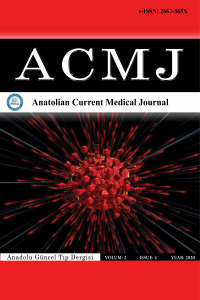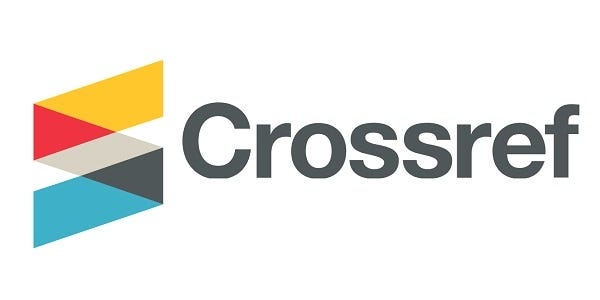Effect of Intraoperative End-Tidal Carbon Dioxide (ETCO2) Levels on Postoperative Nausea and Vomiting in Patients Who Underwent Septorhinoplasty
Abstract
Aim: Postoperative
nausea and vomiting (PONV) is among the most frequent complications of
anesthesia. This condition could lead to major difficulties in the clinical
monitoring of cases after septorhinoplasty. The aim of the present study was to
examine the relationship between end-tidal carbon dioxide (ETCO2)
and PONV in low risk patient group for PONV.
Material
and Method: The study included retrospective analysis of smoking
male cases in the age range of 18-45 years who had septorhinoplasty under
general anesthesia and was evaluated to have class II diagnosis based on American
Society of Anesthesiologists (ASA). The patients who were determined to have
ETCO2 levels of 26-30 mmHg constituted the Group 1, while those who
had 31-35 mmHg were in Group 2. Demographic data and postoperative nausea and
vomiting findings of all cases at the 0th, 2nd, 6th,
12th and 24th hours were evaluated.
Results:
The study included a total of 73 cases. There were no statistical
differences between the two patient groups for demographic data and operation
periods (p>0.05). Nausea incidence at the postoperative 2nd and 6th
hours were significantly higher in Group 1 compared to the Group 2 (p = 0.007
and p = 0.006, respectively). Postoperative vomiting incidence was not
different between the study groups (p>0.05).
Conclusion: Based
on the results of the present study, maintaining the intraoperative ETCO2 levels
in the range of 26-30 mmHg in septorhinoplasty operations results in increased
PONV incidence in the early period.
References
- 1. Bayter M, Peña P, Marquez M, Cárdenas Camarena L, Macias A, Rubio J ve ark. Incidence of postoperative nausea and vomiting when total intravenous anaesthesia is the primary anaesthetic in the ambulatory patient population. Ambul Surg 2018; 24: 8-11. 2. Apfel CC, Laara E. A simplified risk skor for predicting postoperative nausea and vomiting. Anesthesiology 1999; 91: 693-700. 3. Koivuranta M, Laara E, Snare L, Alahuhta S. A survey of postoperative nausea and vomiting. Anaesthesia 1997; 52: 443-9. 4. Shaikh SI, Nagarekha D, Hegade G, Marutheesh M. Postoperative nausea and vomiting: a simple yet complex problem. Anesth Essays Res 2016; 10: 388-96. 5. Son JS, Oh JY, Ko S. Effects of hypercapnia on postoperative nausea and vomiting after laparoscopic surgery: a double-blind randomized controlled study. Surg Endosc 2017; 31: 4576-82. 6. Saghaei M, Matin G, Golparvar M. Effects of intraoperative end-tidal carbon dioxide levels on the rates of post-operative complications in adults undergoing general anesthesia for percutaneous nephrolithotomy: a clinical trial. Adv Biomed Res 2014; 3: 84. 7. Fujimoto D, Egi M, Makino S, Mizobuchi S. The association of intraoperative end-tidal carbon dioxide with the risk of postoperative nausea and vomiting. J Anesth 2020; 34: 195-201. 8. Kizilcik N, Bilgen S, Menda F, et al. Comparison of dexamethasone-dimenhydrinate and dexamethasoneondansetron in prevention of nausea and vomiting in postoperative patients. Aesthetic Plast Surg 2017; 41: 204-10. 9. Pierre S, Whelan R. Nausea and vomiting after surgery. Br J Anaesth Contin Educ Anaesth Crit Care Pain 2013; 13: 28-32. 10. Gan TJ, Diemunsch P, Habib AS, et al. Consensus guidelines for the management of postoperative nausea and vomiting. Anesth Analg 2014; 118: 85‑113. 11. Koivuranta M, Läärä E, Snåre L, Alahuhta S. A survey of postoperative nausea and vomiting. Anaesthesia 1997; 52: 443‑9. 12. Apfel CC, Kranke P, Eberhart LH. Comparison of surgical site and patient’s history with a simplified risk score for the prediction of postoperative nausea and vomiting. Anaesthesia 2004; 59: 1078-82. 13. Marcus JR, Few JW. The prevention of emesis in plastic surgery: a randomized prospective study. Plast Reconstr Surg 2002; 109: 2487-94. 14. Guzman JA, Kruse JA. Splanchnic hemodynamics and gut mucosal-arterial PCO2 gradient during systemic hypocapnia. J Appl Physiol 1985; 1999: 1102-6. 15. Way M, Hill GE. Intraoperative end-tidal carbon dioxide concentrations: What is the target? Anesthesiol Res Pract 2011; 2011: 271539. 16. Teramoto Y, Urano T, Nagai N, Takada Y, Ikeda K, Takada A. Plasma levels of 5-HT and 5-HIAA increased after intestinal ischemia/reperfusion in rats. Jpn J Physiol 1998; 48: 333-9.
Septorinoplasti olan hastalarda farklı intraoperatif end-tidal karbondioksit (ETCO2) değerlerinin postoperatif bulantı kusmaya etkisi
Abstract
Amaç:
Postoperatif
bulantı-kusma (POBK) genel anestezinin en sık görülen komplikasyonlarındandır. Bu
durum septorinoplasti sonrası olguların klinik izlemlerinde büyük güçlüklere
yol açabilmektedir. Çalışmamızda POBK açısından düşük risk grubuna sahip
hastalarda end-tidal karbondioksit (ETCO2) ile POBK arasındaki ilişkinin
incelenmesi amaçlanmıştır.
Gereç
ve Yöntem: Genel
anestezi altında septorinoplasti uygulanan 18-45 yıl yaş aralığında sigara
kullanımı olan ve Amerikan Anestezistler Derneği (ASA) sınıflamasına göre sınıf
II olarak değerlendirilen erkek olguların verileri geriye doğru analiz edildi. ETCO2
değeri 26-30 mmHg olanlar Grup 1, 31-35 mmHg olanlar Grup 2 olarak belirlendi. Tüm
olguların demografik verileri ve postoperatif 0., 2., 6., 12., 24. saatlerde
bulantı-kusma bulguları değerlendirildi.
Bulgular:
Toplam 73 olgu çalışmaya dahil edildi.
Demografik veriler ve operasyon süreleri açısından iki grup arasında
istatistiksel olarak anlamlı farklılık yoktu (p>0,05). Grup 1’de postoperatif
2. ve 6. saatlerde bulantı insidansı Grup 2’ye göre istatistiksel olarak
anlamlı derecede yüksekti (sırası ile p=0,007 ve p=0,006). Gruplar arası
karşılaştırmada postoperatif kusma insidansı açısından anlamlı farklılık yoktu
(p>0,05).
Sonuç:
Çalışmamızda
elde edilen veriler ışığında septorinoplasti operasyonlarında intraoperatif
ETCO2 değerinin 26-30mmHg arasında tutulmasının erken dönemde POBK
insidansında artışa yol açtığı kanaatine varılmıştır.
References
- 1. Bayter M, Peña P, Marquez M, Cárdenas Camarena L, Macias A, Rubio J ve ark. Incidence of postoperative nausea and vomiting when total intravenous anaesthesia is the primary anaesthetic in the ambulatory patient population. Ambul Surg 2018; 24: 8-11. 2. Apfel CC, Laara E. A simplified risk skor for predicting postoperative nausea and vomiting. Anesthesiology 1999; 91: 693-700. 3. Koivuranta M, Laara E, Snare L, Alahuhta S. A survey of postoperative nausea and vomiting. Anaesthesia 1997; 52: 443-9. 4. Shaikh SI, Nagarekha D, Hegade G, Marutheesh M. Postoperative nausea and vomiting: a simple yet complex problem. Anesth Essays Res 2016; 10: 388-96. 5. Son JS, Oh JY, Ko S. Effects of hypercapnia on postoperative nausea and vomiting after laparoscopic surgery: a double-blind randomized controlled study. Surg Endosc 2017; 31: 4576-82. 6. Saghaei M, Matin G, Golparvar M. Effects of intraoperative end-tidal carbon dioxide levels on the rates of post-operative complications in adults undergoing general anesthesia for percutaneous nephrolithotomy: a clinical trial. Adv Biomed Res 2014; 3: 84. 7. Fujimoto D, Egi M, Makino S, Mizobuchi S. The association of intraoperative end-tidal carbon dioxide with the risk of postoperative nausea and vomiting. J Anesth 2020; 34: 195-201. 8. Kizilcik N, Bilgen S, Menda F, et al. Comparison of dexamethasone-dimenhydrinate and dexamethasoneondansetron in prevention of nausea and vomiting in postoperative patients. Aesthetic Plast Surg 2017; 41: 204-10. 9. Pierre S, Whelan R. Nausea and vomiting after surgery. Br J Anaesth Contin Educ Anaesth Crit Care Pain 2013; 13: 28-32. 10. Gan TJ, Diemunsch P, Habib AS, et al. Consensus guidelines for the management of postoperative nausea and vomiting. Anesth Analg 2014; 118: 85‑113. 11. Koivuranta M, Läärä E, Snåre L, Alahuhta S. A survey of postoperative nausea and vomiting. Anaesthesia 1997; 52: 443‑9. 12. Apfel CC, Kranke P, Eberhart LH. Comparison of surgical site and patient’s history with a simplified risk score for the prediction of postoperative nausea and vomiting. Anaesthesia 2004; 59: 1078-82. 13. Marcus JR, Few JW. The prevention of emesis in plastic surgery: a randomized prospective study. Plast Reconstr Surg 2002; 109: 2487-94. 14. Guzman JA, Kruse JA. Splanchnic hemodynamics and gut mucosal-arterial PCO2 gradient during systemic hypocapnia. J Appl Physiol 1985; 1999: 1102-6. 15. Way M, Hill GE. Intraoperative end-tidal carbon dioxide concentrations: What is the target? Anesthesiol Res Pract 2011; 2011: 271539. 16. Teramoto Y, Urano T, Nagai N, Takada Y, Ikeda K, Takada A. Plasma levels of 5-HT and 5-HIAA increased after intestinal ischemia/reperfusion in rats. Jpn J Physiol 1998; 48: 333-9.
Details
| Primary Language | Turkish |
|---|---|
| Subjects | Health Care Administration |
| Journal Section | Original Article |
| Authors | |
| Publication Date | September 23, 2020 |
| Published in Issue | Year 2020 Volume: 2 Issue: 4 |
Cite
Interuniversity Board (UAK) Equivalency: 1b [Original research article published in journals scanned by international field indexes (included in indices other than the ones mentioned in 1a) - 10 POINTS].
The Directories (indexes) and Platforms we are included in are at the bottom of the page.
Journal is indexed in;
Crossref (DOI), Google Scholar, EuroPub, Directory of Research Journal İndexing (DRJI), Worldcat (OCLC), General Impact Factor, OpenAIRE, ASOS Index, ROAD, Turkiye Citation Index, Turk Medline.
Ulakbim-TR Dizin, Index Copernicus, EBSCO, DOAJ is under evaluation.
Journal articles are evaluated as "Double-Blind Peer Review"
.
There is no charge for sending articles, submitting, evaluating and publishing.
Assoc Prof Dr Muhammed KIZILGÜL was qualified as an Associated Editor in ACMJ on 15/02/2020,
Assoc. Prof. Dr. Ercan YUVANÇ leaved, Assoc. Prof. Dr. Alpaslan TANOĞLU became the Editör in Chief in ACMJ on 13/05/2020.








